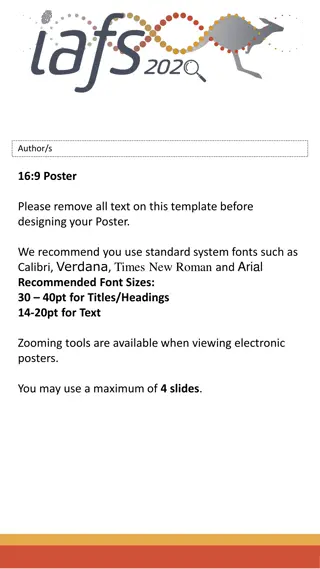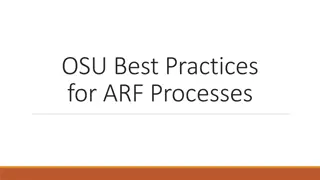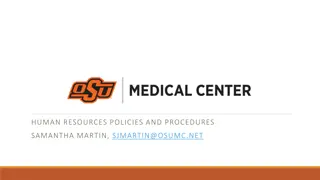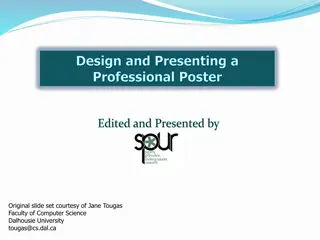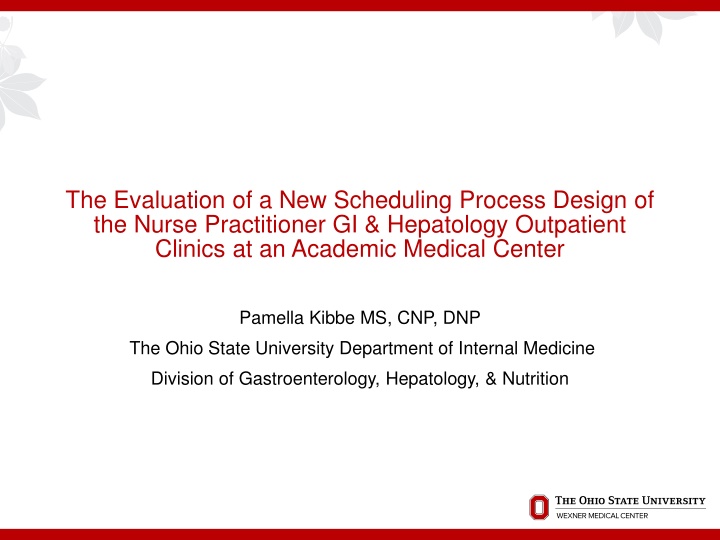
Optimizing NP Scheduling Process Design for Outpatient Clinics
Explore the impact of a new scheduling process on missed patient appointments and NP productivity in GI/Hepatology clinics at an academic medical center. The study aims to address inefficiencies and resource utilization by comparing traditional and advanced scheduling systems.
Uploaded on | 1 Views
Download Presentation

Please find below an Image/Link to download the presentation.
The content on the website is provided AS IS for your information and personal use only. It may not be sold, licensed, or shared on other websites without obtaining consent from the author. If you encounter any issues during the download, it is possible that the publisher has removed the file from their server.
You are allowed to download the files provided on this website for personal or commercial use, subject to the condition that they are used lawfully. All files are the property of their respective owners.
The content on the website is provided AS IS for your information and personal use only. It may not be sold, licensed, or shared on other websites without obtaining consent from the author.
E N D
Presentation Transcript
The Evaluation of a New Scheduling Process Design of the Nurse Practitioner GI & Hepatology Outpatient Clinics at an Academic Medical Center Pamella Kibbe MS, CNP, DNP The Ohio State University Department of Internal Medicine Division of Gastroenterology, Hepatology, & Nutrition
Missed Patient Appointments Significance to Nursing and Healthcare Increasing access and timeliness of care is a goal of the organization Significance of the Problem Patients not showing for their appointments results in wasted resources, increased costs, and under utilization of clinic resources One of the six key elements identified by the Institute of Medicine (IOM) is timeliness of care 2015 a report was drafted from the IOM committee for optimizing scheduling in healthcare to determine why healthcare in the US is not timely Current no show rates in the Division of Gastroenterology, Hepatology, and Nutrition (GHN) are as high as 30% in the NP clinics. Concern for clinical billable productivity which is measured by Relative Value Units (RVU).
PICOT Question Does the current scheduling process compared to the former scheduling process impact the number of patients who miss their appointments thereby affecting NP Provider productivity as evidenced by the number of Subspecialty Clinic RVUs?
Methods Project Design Measures Quality improvement ( QI) approach to utilize data-based method QI methods focus on the new scheduling system. Measure the number of patients who missed appointments and NP productivity measured by RVU (Relative Value Units) in a GI/Hepatology subspecialty clinic. Missed NP appointments Total Number of appointments Total Number of NP appointments completed Productivity measured by NP RVU Data Separate by subspecialty (GI vs. Hepatology) Sample 3 months of retrospective records of NP schedules separated by subspecialty (GI vs. Hepatology) for August, September, & October 2014 (Traditional Scheduling System) & August, September, & October 2015 (Advanced Access/Horizon Scheduling System).
Project Results Retrospective data collection for periods August, September, October 2014 (traditional scheduling system) Retrospective data collection for August, September, and October 2015 (Advanced Access Scheduling System).
Summary of Hepatology Missed NP Appointments 35 30 25 20 2014 2015 15 10 5 0 August September October
Summary of GI NP Missed Appointments 25 20 15 2014 2015 10 5 0 August September October
Hepatology NP RVU Data Summary 120 100 80 60 2014 2015 40 20 0 August September October
GI NP RVU Data Summary 120 100 80 2014 60 2015 40 20 0 August September October
Future Implications Barriers to patients missing appointments (geographic, language, economic, cultural) Payer source Demographic information (age, sex,) Population identified by diagnosis Comparing outcomes of new scheduling system for MD and NP schedules over a longer period of time Evaluation of the recall system
Conclusion Improving Quality patient Care by improving appointment access Evidenced Based Practice Improving outcomes: Optimizing workflow and scheduling process as has been identified by the IOM Improving Productivity





